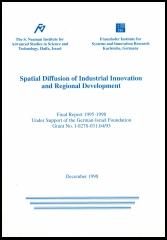פרויקט המחקר נערך במוסד ש. נאמן למחקר מתקדם במדע וטכנולוגיה שבטכניון, בשיתוף פעולה עם מוסד פראונהופר למערכות וחדשנות בקרלסרוה, גרמניה. המחקר מומן על ידי קרן גרמניה-ישראל (GIF). מזה זמן רב ישנה הכרה בתפקיד המכריע שיש לחידושים בתעשייה בעידוד הצמיחה הכלכלית באזור. מטרתו העיקרית של פרויקט מחקר זה לזהות את הגורמים האחראים להפצה המרחבית של החידושים בתעשייה ולבחון את ההשפעה של החידושים על הפיתוח האזורי בישראל ובגרמניה. באופן כללי, קיים דמיון רב בתדירות הופעתה של חדשנות תעשייתית בשתי המדינות: לדוגמה, שיעור החדשנות בקרב פירמות הי-טק בהשוואה לזה של חברות מסורתיות גבוה באופן ניכר וההבדל נמצא מובהק סטטיסטית. מצד שני, המבנה והשונות המרחבית הקיימת בישראל בשיעור החדשנות היא גדולה יותר וגלויה בהשוואה לממצאים המדווחים מגרמניה. בישראל ככל שיוצאים מהמרכז לעבר הפריפריה שיעור החדשנות בקרב הפירמות פוחת בהדרגתיות.
 / דוחות ומחקרים / מרחבית של חדשנות בתעשייה ופיתוח אזורי
/ דוחות ומחקרים / מרחבית של חדשנות בתעשייה ופיתוח אזורי











